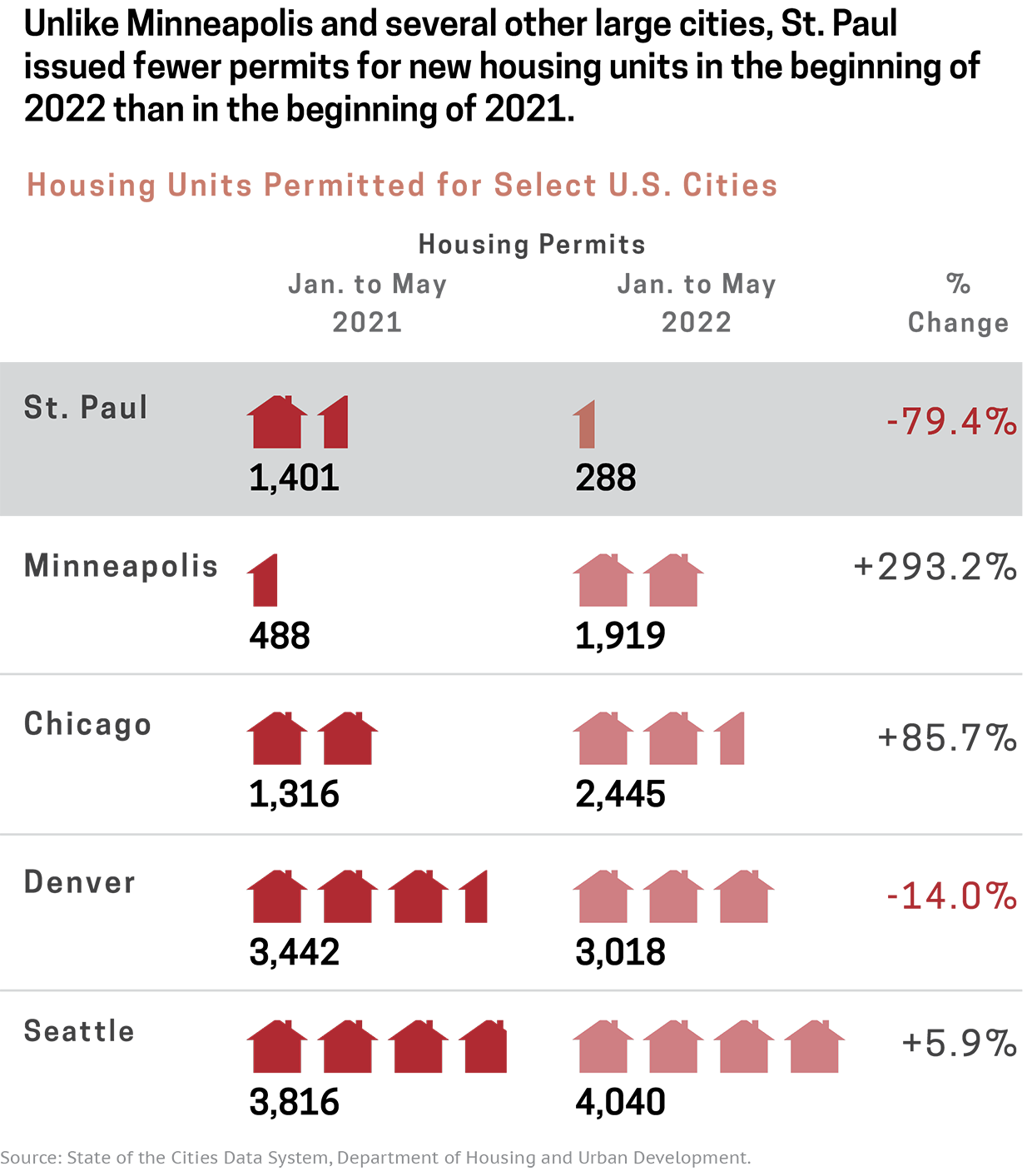
This research highlight is part of the recently-released annual report of the Institute's "Promise: Investing in Community" major research initiative.
by Brian Asquith
Policy Recommendations
- Rent control is a mixed bag: its potential to tame price increases for tenants should be weighed against its potential to reduce property values (and thus drive down property tax collection).
-
Increasing density does not have to mean new large apartment complexes. Encouraging development of duplexes and triplexes can significantly ease housing shortages.
-
Reforming housing policy includes many options besides abolishing single-family zoning. Removing minimum parking requirements for new developments and allowing denser housing construction around commercial corridors can also help alleviate affordable housing shortages.
Forget what you may have previously believed: affordable housing is no longer just a coastal problem. As documented by the New York Times in the summer of 2022, the places no longer building enough housing to meet demand now stretch across many Western, Midwestern, and Southern metro areas, including cities like Grand Rapids, Denver, Austin, and Minneapolis-St. Paul.
The Twin Cities in particular have been on a growth tear: between 2010 and 2020, Minneapolis added 41,000 residents (a 12.4 percent increase) and about 28,500 housing units. In contrast, St. Paul added 26,000 residents (a 9.3 percent increase) but only 8,000 housing units. Though faced with similar growth, policymakers in the two cities are taking starkly different approaches to resolving their housing shortfalls.
In October 2019, the Minneapolis City Council adopted a strategic plan called “Minneapolis 2040”; one of its stated aims was to have “…all Minneapolis residents [be able] to afford and access quality housing throughout the city.” The plan explicitly called for the city to “expand opportunities to increase the housing supply… [by] …allowing more housing options.” Key reforms included ending minimum parking space requirements for new developments, allowing for greater housing density in major commercial corridors, and most (in)famously, the abolition of single-family zoning. Effectively, this reform allowed developers to build multifamily housing on any open residentially zoned parcel in the city.
St. Paul, by contrast, has mostly eschewed supply-side reforms in favor of a blunter tool: rent control. In November 2021, St. Paul voters narrowly passed a referendum enacting what is arguably the strictest rent control regime of any major U.S. city. St. Paul’s rent control system has two distinct features that set it apart from other cities’ systems. The first is that it tightly restricts the amount a landlord can ask for a newly vacant unit, called a “vacancy bonus,” to just 3 percent above what was asked of the vacating tenant. Only New York City’s limit of a zero-vacancy bonus is stricter; most other systems either do not regulate vacancy bonuses at all or allow them to be much more generous, like Washington D.C.’s 10 percent. The other distinct provision is that, unlike all other systems, new construction is not automatically exempt from rent controls.

After the St. Paul referendum was passed last fall, I predicted that these provisions would likely cause both new developments and the existing rental housing stock to fall because many landlords would seek to switch their rental units to condominiums and cash out of the St. Paul market. That prediction was informed by several papers, largely using data from San Francisco, that had found that landlords subject to rent control often reduce the number of units for rent, even when rents increase (Asquith 2019; Diamond, McQuade, and Qian 2019). Recent research by Ahern and Giacoletti (2022) implies that the referendum also affected property values, which in the first three months after the referendum passed fell by 6–7 percent, a loss of $1.6 billion.
While we are still waiting for research on other aspects of St. Paul’s new ordinance and Minneapolis’s new housing plan, housing permit data provide a few clues. Figure 1 shows changes in the number of multifamily housing unit permits issued for select cities between the first five months of 2021 and of 2022.
The contrast between St. Paul and Minneapolis could not be clearer. Minneapolis is building a substantial pipeline of new, multifamily projects that will add hundreds of new units to its existing housing stock. St. Paul, however, has seen a marked slowdown in units permitted despite sharing the same climate, geography, and local labor market. Even when compared to other cold weather cities with strong tech sectors, like Seattle, Denver, and Chicago, the drop in the number of permits in St. Paul clearly stands out.
A growing body of research, including Asquith, Mast, and Reed (forthcoming), Li (forthcoming), and Pennington (2021), has shown that expanding the housing supply eases rent pressures in the local housing market. While it is still uncertain whether market rate housing developments or rent control is more effective at alleviating price pressures, preliminary data from the Twin Cities seem to favor development.
While it is still too early to draw a firm conclusion on which policy will best promote more affordable housing to city residents, the early evidence favors modest policy reforms that encourage density and housing development over more direct price interventions like rent control.
To learn more about how cities can address their housing issues, please check out Brian Asquith's latest work: https://works.bepress.com/brian-asquith/20/.
To read more, please check out the rest of our latest report: https://www.upjohn.org/major-initiatives/promise-investing-community/about-initiative/annual-reports.
References
Ahern, Kenneth R., and Marco Giacoletti. 2022. “Robbing Peter to Pay Paul? The Redistribution of Wealth Caused by Rent Control.” NBER Working Paper No. 30083. Cambridge, MA: National Bureau of Economic Research.
Asquith, Brian. 2019. “Do Rent Increases Reduce the Housing Supply Under Rent Control? Evidence from Evictions in San Francisco.” Upjohn Institute Working Paper No. 19-296. Kalamazoo, MI: W.E. Upjohn Institute for Economic Research.
Asquith, Brian, Evan Mast, and Davin Reed. Forthcoming. “Local Effects of Large New Apartment Buildings in Low-Income Areas.” Review of Economics and Statistics.
Diamond, Rebecca, Timothy McQuade, and Franklin Qian. 2019. “The Effects of Rent Control Expansion on Tenants, Landlords, and Inequality: Evidence from San Francisco.” American Economic Review 109(9): 3365–3394.
Li, Xiaodi. 2021. “Do New Housing Units in Your Backyard Raise Your Rents.” Journal of Economic Geography.
Pennington, Kate. 2021. “Does Building New Housing Cause Displacement? The Supply and Demand Effects of Construction in San Francisco.” Working paper. Berkeley: University of Berkeley.

